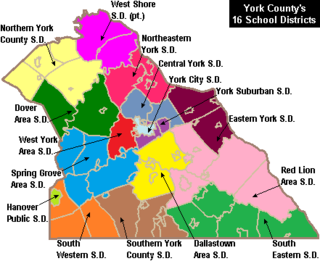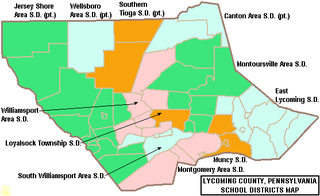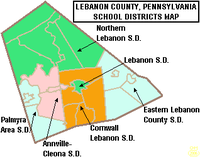
The Dover Area School District is a midsized, rural, public school district located in York County, Pennsylvania. It serves Dover Township and the Borough of Dover. According to the 2010 United States Census, the district community's population grew to 25,779 people. The population of the district was 22,349 people, according to the 2000 federal census. The educational attainment levels for the Dover Area School District population were 87% high school graduates and 14.7% college graduates.

Solanco School District is a large, rural public school district located in the southern end of Lancaster County, Pennsylvania. Solanco School District encompasses approximately 180 square miles (470 km2). Solanco School District serves: Providence Township, Eden Township, Quarryville Borough, Little Britain Township, Bart Township, Colerain Township, Drumore Township, East Drumore Township and Fulton Township. According to 2008 local census data, it served a resident population of 30,566. By 2010, the district's population increased to 31,871 people. In 2009, the district residents’ per capita income was $17,040, while the median family income was $49,432. In the Commonwealth, the median family income was $49,501 and the United States median family income was $49,445, in 2010.

West York Area School District is a midsized, suburban public school district located in York County in South Central Pennsylvania, United States. The West York Area School District includes West York Borough and West Manchester Township. It encompasses approximately 21 square miles (54 km2). According to 2000 federal census data, it served a resident population of 21,356. By 2010, the District's population grew to 23,664 people. In 2009, the District residents’ per capita income was $21,915, while the median family income was $52,309. In the Commonwealth, the median family income was $49,501 and the United States median family income was $49,445, in 2010.

The Bloomsburg Area School District is a small, suburban/rural public school district. The district is one of the 500 school districts of Pennsylvania. The Bloomsburg Area School District serves the Town of Bloomsburg and Beaver Township, Hemlock Township, Main Township and Montour Township in Columbia County, Pennsylvania. The district encompasses approximately 81 square miles (210 km2). According to 2000 federal census data, it served a resident population of 17,860. By 2010, the district's population increased to 20,654 people. The educational attainment levels for the district's population were 91.5% high school graduates and 26.4% college graduates.

The Danville Area School District is a midsized, rural, public school district which spans portions of two counties in Pennsylvania. In Montour County it covers the Boroughs of Danville and Washingtonville and Cooper Township, Derry Township, Liberty Township, Mahoning Township, Mayberry Township, Valley Township and West Hemlock Township. In Northumberland County it covers the Borough of Riverside and Rush Township. The district encompasses approximately 120 square miles (310 km2). According to 2000 federal census data, it served a resident population of 18,894. By 2010, the district's population declined to 18,765 people. The educational attainment levels for the Danville Area School District population were 89.8% high school graduates and 27.4% college graduates.

The Halifax Area School District is a small, suburban, public school district located in Halifax, Pennsylvania in Dauphin County. The district served 1,143 students in preschool to grade 12 in 2012. Halifax Area School District encompasses approximately 83 square miles (210 km2). The district serves residents of: Halifax Borough, Halifax Township, Jackson Township and Wayne Township. According to 2000 federal census data, Halifax Area School District served a resident population of 7,366 people. By 2010, the district's population increased to 7,606 people.

Lower Dauphin School District is a midsized, suburban public school district located in Dauphin County, Pennsylvania. The district encompasses approximately 89 square miles (230 km2) and serves the Borough of Hummelstown, as well as the Townships of East Hanover, Londonderry, South Hanover, and Conewago. According to 2000 federal census data, the district served a resident population of 22,546. By 2010, the district's population increased to 24,747 people. The educational attainment levels for the district's population were 91.2% high school graduates and 28.2% college graduates. The district is one of the 500 public school districts of Pennsylvania.

Stroudsburg Area School District is a large, suburban/rural public school district located in the Pocono Mountains in Northeastern Pennsylvania. The headquarters are located on West Main Street in Stroudsburg, Pennsylvania. Stroudsburg Area School District encompasses approximately 73 square miles (190 km2).

The Boyertown Area School District is a large public school district which covers portions of Berks and Montgomery Counties in southeastern Pennsylvania. When the Boyertown Area School District was formed in 1953 it was one of the largest in the state, encompassing 100 square miles (260 km2). In Berks County it covers the Boroughs of Bally, Bechtelsville and Boyertown and Colebrookdale Township, Douglass Township, Earl Township and Washington Township. In Montgomery County it covers Douglass Township, New Hanover Township and Upper Frederick Township.

Wayne Highlands is a third-class school district in Wayne County, Pennsylvania. The district's population was 20,870 at the time of the 2010 United States Census.

The Brockway Area School District is a small, rural public school district located in north west Pennsylvania, US. The District encompasses approximately 147 square miles (380 km2) spanning portions of two counties. In Elk County it covers a small portion of Horton Township. In Jefferson County it covers the Borough of Brockway and Polk Township, Snyder Township and Washington Township. The district operates one elementary school and Brockway Area Junior/Senior High School. The district is with the Riverview Intermediate Unit 6 region. The Intermediate Unit provides support services and therapy to special education students. It also provides training to school personnel.

The Bald Eagle Area School District is a midsized, suburban/rural public school district located in Centre County, Pennsylvania. The district serves the Boroughs of Howard, Milesburg, Port Matilda, Snow Shoe and Unionville and Boggs Township, Burnside Township, Howard Township, Huston Township, Snow Shoe Township, Union Township and Worth Township in Centre County, Pennsylvania. Bald Eagle Area School District encompasses approximately 345 square miles (890 km2). According to 2000 federal census data, it serves a resident population of 12,882. By 2010, the district's population increased to 13,218.

The Derry Township School District is a midsized, suburban public school district which serves Derry Township in Dauphin County, Pennsylvania. The district includes the unincorporated Village of Hershey. Derry Township School District encompasses approximately 27 square miles (70 km2). According to 2000 federal census data, it serves a resident population of 21,273. By 2010, the district's population increased to 24,690 people. The educational attainment levels for the Derry Township School District population were 94% high school graduates and 51.4% college graduates. Pennsylvania State University's Hershey Medical Center is located within the district boundaries. Derry Township School District is one of the 500 public school districts of Pennsylvania.

The West Middlesex Area School District is a small, rural public school district serving the southwestern portion of Mercer County, Pennsylvania. It encompasses the communities of West Middlesex, Shenango Township, and Lackawannock Township. The West Middlesex Area School District encompasses approximately 52 square miles (130 km2). The district operates on a single 40-acre campus. According to 2000 federal census data, it served a resident population of 7,527. By 2010, the district's population declined to 7,454 people. In 2009, the district residents’ per capita income was $16,870, while the median family income was $40,558. In the Commonwealth, the median family income was $49,501 and the United States median family income was $49,445, in 2010.
The Williams Valley School District is a small, rural public school district located in Dauphin County, Pennsylvania and Schuylkill County, Pennsylvania. The district is highly fragmented, encompassing the boroughs of Williamstown and Tower City as well as the townships of Porter, Rush, Williams, and Wiconisco. The district encompasses approximately 62 square miles (160 km2).

The Upper Dauphin Area School District is a small, rural, public school district located in Dauphin County, Pennsylvania. It is fragmented in four discontinuous pieces, including: the boroughs of Lykens, Elizabethville, Gratz, Berrysburg, and Pillow, as well as Jefferson Township, Washington Township, Mifflin Township, and Lykens Township. Upper Dauphin Area School District encompasses approximately 91 square miles (240 km2). According to 2007 local census data, it serves a resident population of 9,723 people. By 2010, the district's population was 9,759 people. The educational attainment levels for the district's population aged 25 years and over were 81.4% high school graduates and 10.6% college graduates.

The Wellsboro Area School District is a small, rural/suburban public school district located in central Tioga County. Wellsboro Area School District encompasses approximately 330 square miles (850 km2). The district serves the borough of Wellsboro and also serves: Middlebury Township, Charleston Township, Delmar Township, Duncan Township, and Shippen Township. Pine Township in Lycoming County, Pennsylvania, which is not connected to the rest of the district, is also served. According to 2000 federal census data, the district served a resident population of 11,689. By 2010, the District's population rose slightly to 11,800 people. The educational attainment levels for the Wellsboro Area School District population were 90.2% high school graduates and 24.3% college graduates. The district is one of the 500 public school districts of Pennsylvania.

The South Williamsport Area School District is a small public school district in Lycoming County, Pennsylvania, in the United States. The school serves several suburbs of Williamsport, including South Williamsport, DuBoistown, Susquehanna Township, and Armstrong Township. The district encompasses approximately 36 square miles (93 km2). According to 2000 federal census data, it served a resident population of 9,400. By 2010, the district's population declined to 9,268 people. In 2009, the district residents’ per capita income was $18,650, while the median family income was $41,002. In the Commonwealth, the median family income was $49,501 and the United States median family income was $49,445, in 2010. By 2013, the median household income in the United States rose to $52,100.

The Northern Tioga School District is a rural public school district operating in Tioga County, Pennsylvania, US. The district serves an extensive rural region, spanning 335 square miles (870 km2) across the northern section of Tioga County. Northern Tioga School District is a third class school district having less than 30,000 residents and is one of the 500 public school districts of Pennsylvania. Municipalities served include: Tioga, Tioga Township, Jackson Township, Lawrenceville, Lawrence Township, Farmington Township, Elkland, Osceola Township, Knoxville, Chatham Township, Deerfield Township, Brookfield, Westfield, and Clymer Township. According to 2000 federal census data, it served a resident population of 14,670. By 2010, the district's population declined to 14,523 people. The educational attainment levels for the Northern Tioga School District population were 85.6% high school graduates and 11.7% college graduates.

The South Eastern School District is a midsized, rural, public school district in southern York County, Pennsylvania. It serves the boroughs of Cross Roads, Stewartstown, Delta, and Fawn Grove, plus the townships of Hopewell Township, East Hopewell Township, Fawn Township, and Peach Bottom Township. It also includes the villages of Bryansville and Woodbine. The district encompasses approximately 105 square miles (270 km2). According to data from the 2000 federal census, it serves a resident population of 17,884 people. By 2010, South Eastern School District's population increased to 19,567 people. In 2009, the district residents’ per capita income was $20,060, while the median family income was $55,846. In the Commonwealth, the median family income was $49,501 and the United States median family income was $49,445, in 2010.














